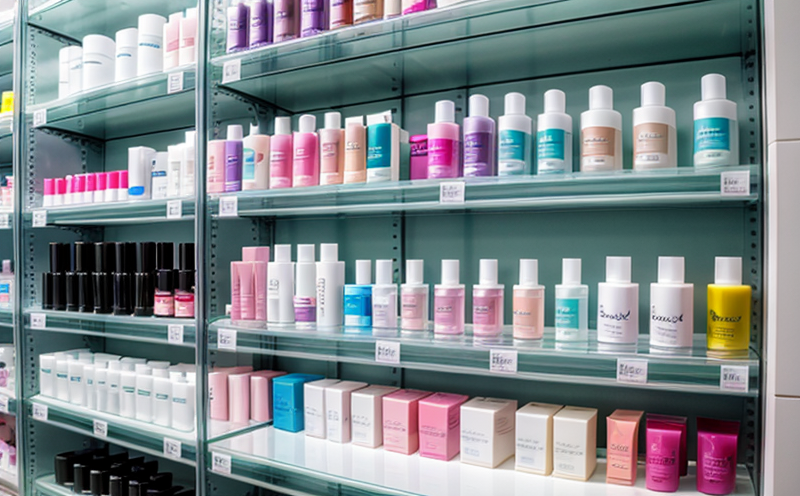Shelf Life Testing of Natural and Organic Cosmetics
The shelf life testing of natural and organic cosmetics is a critical component in ensuring product safety, efficacy, and consumer satisfaction. With increasing demand for sustainable and eco-friendly products, the need to validate these formulations over time has become more important than ever. This service focuses on assessing the stability and shelf life of cosmetic products formulated with natural ingredients and those certified as organic.
Shelf life testing involves subjecting cosmetic samples to real-world environmental conditions that simulate storage and usage scenarios. The goal is to determine how well these products maintain their quality, safety, and effectiveness over time without compromising regulatory compliance or consumer expectations. This process helps manufacturers ensure that their products remain safe and effective throughout the intended shelf life.
For natural and organic cosmetics, this testing is particularly challenging due to the inherent variability in raw materials sourced from nature. Factors such as temperature, humidity, light exposure, and even packaging can significantly impact the stability of these formulations. Therefore, it is essential for manufacturers to conduct rigorous stability studies that account for all potential influencing factors.
The shelf life testing process typically begins with selecting appropriate test conditions based on industry standards like ISO 25013 or ASTM F1929. These guidelines provide a framework for simulating various environmental stressors, including temperature and humidity cycling, light exposure, and storage under different temperatures. By subjecting samples to these controlled environments, we can accurately assess the degradation rates of active ingredients and other components.
Once the test conditions are established, the next step involves preparing the specimens according to specific protocols. This may include re-formulating the product into containers suitable for testing or adjusting ingredient concentrations if necessary. After preparation, samples are subjected to accelerated aging processes designed to mimic extended periods of real-time storage and use.
During this phase, detailed observations are made regarding changes in physical properties such as color, texture, viscosity, and odor. Additionally, chemical analyses are performed using advanced analytical techniques like HPLC (High-Performance Liquid Chromatography) or GC (Gas Chromatography). These methods allow us to detect subtle shifts in the composition of the formulation over time.
Another crucial aspect of shelf life testing is evaluating microbiological stability. Natural ingredients often contain beneficial microorganisms that contribute to their unique characteristics but also pose risks if not properly controlled. By monitoring microbial growth and viability throughout the test period, we can ensure that these products remain safe for use even after extended storage.
Once all data has been collected, comprehensive reports are generated summarizing findings from both physical and chemical analyses. These documents provide valuable insights into the stability of natural and organic cosmetics under various conditions, enabling manufacturers to make informed decisions about product labeling, formulation adjustments, and overall quality control.
| Test Condition | Description |
|---|---|
| Temperature Cycling | Cycles between extreme temperatures to simulate storage in hot climates. |
| Humidity Exposure | Exposes samples to high humidity levels to assess moisture resistance. |
| Light Exposure | Subjcts samples to prolonged UV light exposure to evaluate photostability. |
| Aging at Elevated Temperatures | Tests samples stored at elevated temperatures over extended periods. |
In conclusion, shelf life testing plays a vital role in ensuring the quality and safety of natural and organic cosmetics. By following stringent protocols and utilizing advanced analytical techniques, we can provide reliable data that helps manufacturers extend product lifecycles while maintaining regulatory compliance.
Scope and Methodology
The scope of shelf life testing for natural and organic cosmetics encompasses several key aspects. It includes assessing the stability of both physical properties such as color, texture, viscosity, and odor, as well as chemical composition through various analytical techniques.
- Physical Property Monitoring: This involves regular observation and measurement of changes in appearance over time. For instance, tracking any alterations in hue or consistency can indicate potential issues with ingredient integrity.
- Chemical Analysis: Utilizing sophisticated instruments like HPLC or GC allows us to monitor shifts in the chemical makeup of the formulation. Detecting even minor variations helps identify degradation processes early on.
The methodology employed ensures that each step adheres strictly to relevant international standards such as ISO 25013 and ASTM F1929. These guidelines provide clear instructions for setting up test conditions, interpreting results, and reporting findings accurately.
Benefits
- Increased Consumer Confidence: By demonstrating that your products remain safe and effective over extended periods, you build trust with consumers.
- Extended Product Lifecycles: Accurate shelf life testing allows for the extension of product lifecycles without compromising quality or safety.
- Regulatory Compliance: Ensures that all claims about shelf life are backed by scientific evidence, facilitating smoother interactions with regulatory bodies.
- Improved Quality Control: Identifies potential issues early on so they can be addressed before reaching the market.
Quality and Reliability Assurance
- Compliance with Standards: Adherence to international standards ensures consistent, reliable results that meet industry expectations.
- Expertise in Natural and Organic Cosmetics: Our team possesses deep knowledge specifically tailored towards natural and organic formulations, ensuring accurate assessments.
- State-of-the-Art Facilities: Equipped with cutting-edge instrumentation capable of detecting minute changes in formulation composition.





